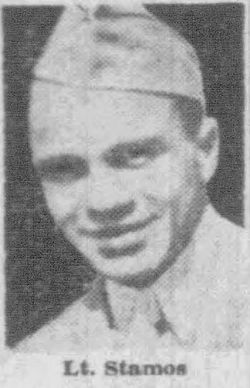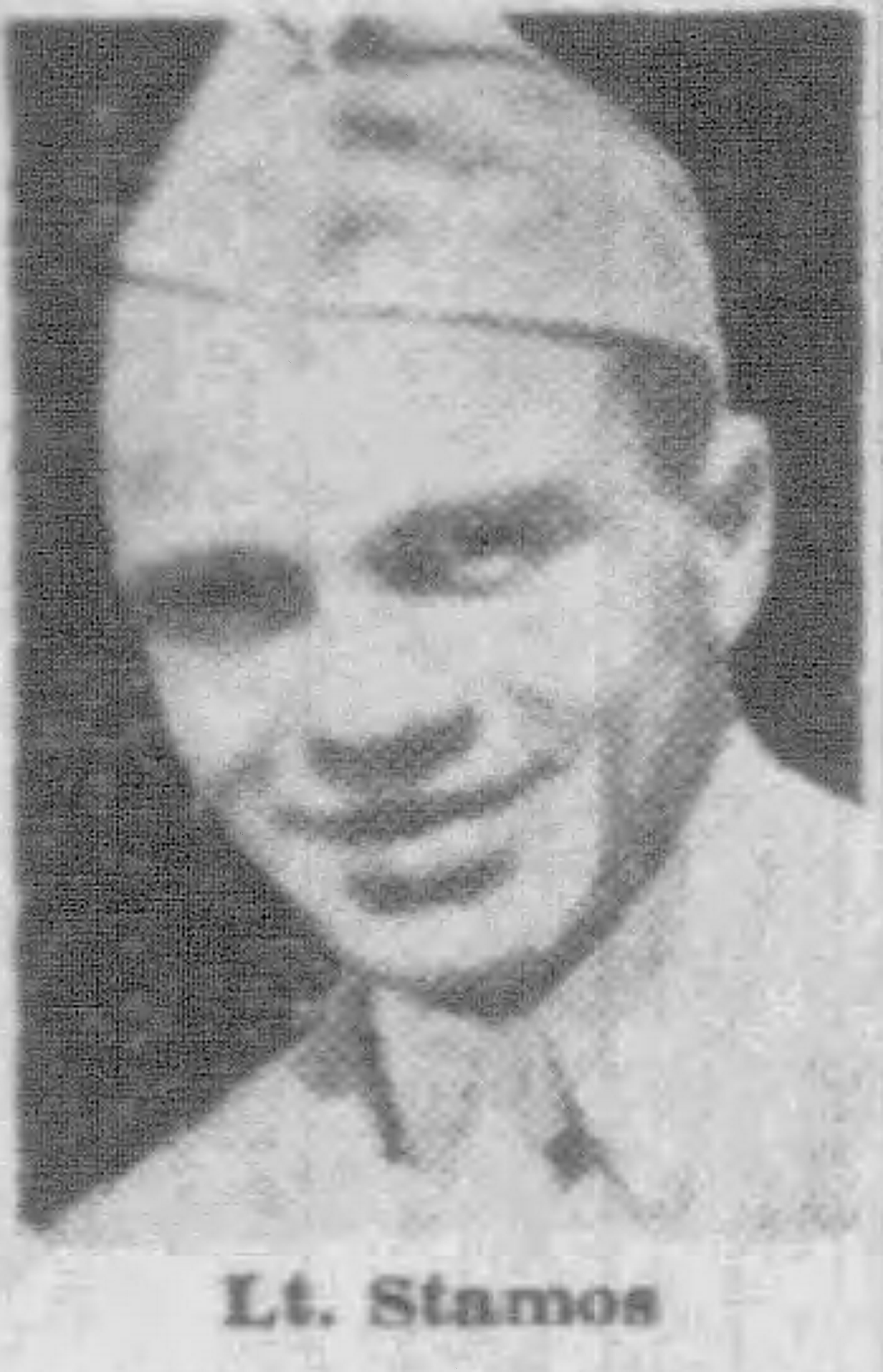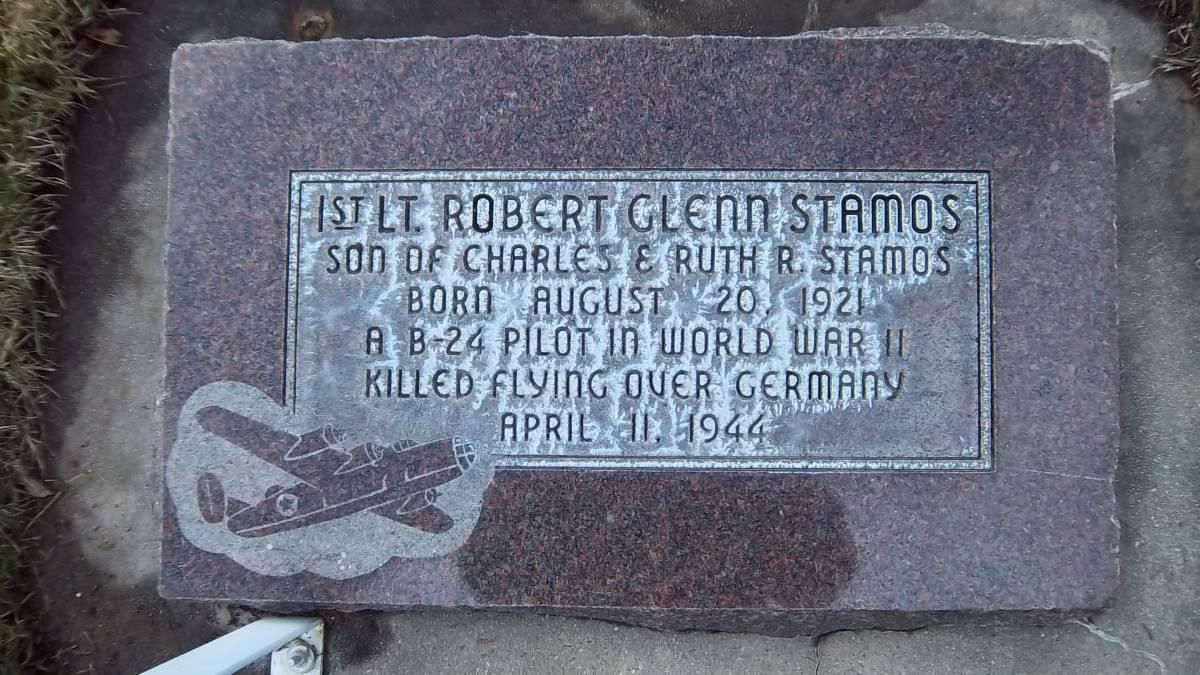Co Pilot 1st/Lt. Robert G. Stamos
Hometown: Danville, Illinois
Squadron: 506th Sq. 44th Bomb Group
Service# O-730646
Awards: Purple Heart
Pilot 1st/Lt. John D. Money POW
MACR #3848
Target: Bernberg, Germany
Mission Date: 11-Apr-44
Serial Number: #42-7522
Aircraft Model B-24
Aircraft Letter: S-Bar
Aircraft Name: SOUTHERN COMFORT II
Location: Germany
Cause: Mechanical failure/ flak
Crew of 10 7KIA 3POW
For the third straight time, fierce enemy opposition from the air as well as from the ground was experienced by our Group. The specific target was the Junkers Aircraft Assembly Plant, which was bombed with good results. One aircraft did not return, a 506th plane piloted by Lt. John D. Money.
The MACR states that this aircraft went down at 1123 hours. The right bomb bay doors failed to open, so when the bombs were dropped, the right side fragmentation bombs hit the closed doors, immediately setting that area on fire. The ship flew on for awhile, then winged over, breaking in two at the waist section. It went down and exploded. Four bodies came clear of the falling wreckage, but only two chutes were seen to open. Sgt. Wallace Kirschner, left waist gunner, sent his experiences, “According to my diary, we had flown nine missions prior to this one on 11 April. We were carrying incendiary bombs. Near the target, we were under a barrage of flak, getting set for our bomb run. The bomb bay doors would not open as the tracks were frozen tight. Upon informing Lt. Money, our pilot, that I could not break the ice, we received a direct hit in the bomb bay. The rest is history. “Sgt. Roop, tail gunner, saw that Sgt. Young’s hands were badly burned, took his own parachute and placed it on Sgt. Young and helped him get through the rear camera hatch door. This resulted in Sgt. Roop being without a parachute of his own. I followed Young out the rear hatch, after removing my oxygen mask because I couldn’t get the hose to release from the regulator. With the mask removed, I got 3rd degree burns on my face and right hand due to the fire all around me. “I was picked up by German soldiers upon landing and was taken to an aid station in Frankfurt. They had converted an Agricultural School into a hospital. The doctors and aids were all part of the Dunkirk Evacuation Force captured – who were a wonderful group of men. Then I was sent to Bad Soden for work on my eyes. Even the doctors there were also from Dunkirk. I was later repatriated and returned to the States on 21 February, 1945. I saw Sgt. Young once after the war.” Lt. Money wrote that, “When the fire erupted in the bomb bay it quickly spread forward, filling the cabin with fire and smoke. I gave the bail out signal, as my co-pilot, Robert Stamos, was already dead from flak wounds. I then contemplated my own escape from that inferno. There was absolutely no way I could get back to the bomb bay, and the top hatch itself was burning. So it would have to be out one of the windows, but they were still intact. While still trying to maintain some control of the craft, I got my feet up, braced my back, and succeeded in kicking out the Co-pilot’s side window. “Then I managed to get over Stamos, got hold of his wheel, and continued to hold the plane under control as I worked myself out that window. Soon I was entirely outside the ship, but still holding onto the wheel as I needed to tilt the plane right-wing high, as that #3 prop was still churning the air a very short distance behind me. “Then I let go – and immediately got clipped on my head by a tip of one of the propeller blades that knocked me out. But the cold air brought me to my senses before I hit the ground and I got my chute open in time. On the ground I found I was not seriously injured, and soon was taken prisoner.” James H. Stevens was part of Capt. Schmidt’s crew (K-314 ). He saw Money’s aircraft go down and spotted two chutes. He noted that on this mission his aircraft’s nose turret was demolished, one engine was knocked out, and one tail section was shot up, but the aircraft returned safely to Shipdham. He wrote: “Lew Karstadt (in the nose turret) was saved by the rather small panel of armored glass. When we all got out of our flight gear at the base later on, we found that Lew had been the only one wounded in the attack. As I recall, it was a flak fragment in his knee.”
SOUTHERN COMFORT II Crew
1st/Lt. John D. Money POW Pilot
1st/Lt. Robert G. Stamos Co Pilot KIA
1st/Lt. Harold J. Wheatly Navigator KIA
T/Sgt. Andrew C. Graff Engineer KIA
T/Sgt. Andrew C. Graff Engineer KIA
T/Sgt. Edward A. Wernicki Radio Op. KIA
S/Sgt. Herbert S. Hill Gunner POW
S/Sgt. Donald L. Young Gunner POW
S/Sgt. Foster A. Blake Gunner KIA
S/Sgt. Wallace E. Kirschner Gunner POW
S/Sgt. Eugene W. N. Roop Gunner
Co Pilot 1st/Lt. Robert G. Stamos
Hometown: Danville, Illinois
Squadron: 506th Sq. 44th Bomb Group
Service# O-730646
Awards: Purple Heart
Pilot 1st/Lt. John D. Money POW
MACR #3848
Target: Bernberg, Germany
Mission Date: 11-Apr-44
Serial Number: #42-7522
Aircraft Model B-24
Aircraft Letter: S-Bar
Aircraft Name: SOUTHERN COMFORT II
Location: Germany
Cause: Mechanical failure/ flak
Crew of 10 7KIA 3POW
For the third straight time, fierce enemy opposition from the air as well as from the ground was experienced by our Group. The specific target was the Junkers Aircraft Assembly Plant, which was bombed with good results. One aircraft did not return, a 506th plane piloted by Lt. John D. Money.
The MACR states that this aircraft went down at 1123 hours. The right bomb bay doors failed to open, so when the bombs were dropped, the right side fragmentation bombs hit the closed doors, immediately setting that area on fire. The ship flew on for awhile, then winged over, breaking in two at the waist section. It went down and exploded. Four bodies came clear of the falling wreckage, but only two chutes were seen to open. Sgt. Wallace Kirschner, left waist gunner, sent his experiences, “According to my diary, we had flown nine missions prior to this one on 11 April. We were carrying incendiary bombs. Near the target, we were under a barrage of flak, getting set for our bomb run. The bomb bay doors would not open as the tracks were frozen tight. Upon informing Lt. Money, our pilot, that I could not break the ice, we received a direct hit in the bomb bay. The rest is history. “Sgt. Roop, tail gunner, saw that Sgt. Young’s hands were badly burned, took his own parachute and placed it on Sgt. Young and helped him get through the rear camera hatch door. This resulted in Sgt. Roop being without a parachute of his own. I followed Young out the rear hatch, after removing my oxygen mask because I couldn’t get the hose to release from the regulator. With the mask removed, I got 3rd degree burns on my face and right hand due to the fire all around me. “I was picked up by German soldiers upon landing and was taken to an aid station in Frankfurt. They had converted an Agricultural School into a hospital. The doctors and aids were all part of the Dunkirk Evacuation Force captured – who were a wonderful group of men. Then I was sent to Bad Soden for work on my eyes. Even the doctors there were also from Dunkirk. I was later repatriated and returned to the States on 21 February, 1945. I saw Sgt. Young once after the war.” Lt. Money wrote that, “When the fire erupted in the bomb bay it quickly spread forward, filling the cabin with fire and smoke. I gave the bail out signal, as my co-pilot, Robert Stamos, was already dead from flak wounds. I then contemplated my own escape from that inferno. There was absolutely no way I could get back to the bomb bay, and the top hatch itself was burning. So it would have to be out one of the windows, but they were still intact. While still trying to maintain some control of the craft, I got my feet up, braced my back, and succeeded in kicking out the Co-pilot’s side window. “Then I managed to get over Stamos, got hold of his wheel, and continued to hold the plane under control as I worked myself out that window. Soon I was entirely outside the ship, but still holding onto the wheel as I needed to tilt the plane right-wing high, as that #3 prop was still churning the air a very short distance behind me. “Then I let go – and immediately got clipped on my head by a tip of one of the propeller blades that knocked me out. But the cold air brought me to my senses before I hit the ground and I got my chute open in time. On the ground I found I was not seriously injured, and soon was taken prisoner.” James H. Stevens was part of Capt. Schmidt’s crew (K-314 ). He saw Money’s aircraft go down and spotted two chutes. He noted that on this mission his aircraft’s nose turret was demolished, one engine was knocked out, and one tail section was shot up, but the aircraft returned safely to Shipdham. He wrote: “Lew Karstadt (in the nose turret) was saved by the rather small panel of armored glass. When we all got out of our flight gear at the base later on, we found that Lew had been the only one wounded in the attack. As I recall, it was a flak fragment in his knee.”
SOUTHERN COMFORT II Crew
1st/Lt. John D. Money POW Pilot
1st/Lt. Robert G. Stamos Co Pilot KIA
1st/Lt. Harold J. Wheatly Navigator KIA
T/Sgt. Andrew C. Graff Engineer KIA
T/Sgt. Andrew C. Graff Engineer KIA
T/Sgt. Edward A. Wernicki Radio Op. KIA
S/Sgt. Herbert S. Hill Gunner POW
S/Sgt. Donald L. Young Gunner POW
S/Sgt. Foster A. Blake Gunner KIA
S/Sgt. Wallace E. Kirschner Gunner POW
S/Sgt. Eugene W. N. Roop Gunner
Family Members
Other Records
Sponsored by Ancestry
Advertisement
Records on Ancestry
Advertisement










